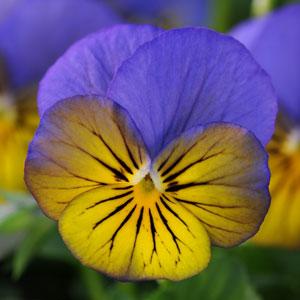Germination
Approximate seed count: 20,000 to 31,500 S./oz. (700 to 1,100 S./g)
A medium covering of coarse grade vermiculite is recommended to help maintain high humidity around the germinating seed for better germination performance. Bench germination takes 3 to 4 days. Chamber germination will yield better results.
For optimal germination performance, maintain the plug media at “wet” moisture levels, i.e., the media is glistening, but water will not ooze out from the bottom of the tray and will penetrate only slightly from the top around the fingertip. Avoid germination temperatures above 70°F (21°C) to prevent seedling stretch.
Plug Production
Plug Tray Size: Use 406-cell plug trays. Finish time is about 4 weeks.
Media: Use a well-drained, disease-free seedling medium with a pH of 5.4 to 5.8. Avoid plug media mixes with a high initial nutrient charge. Keep phosphorus levels as low as possible to avoid initial stretch.
Stage 2 timing: 10 days
Stage 3 timing: 14 days
Stage 4 timing: 7 days
Temperature
Germination: 68°F (20°C)
Stage 2: 65° to 70°F (18 to 21°C) days; 60°F (15°C) nights
Stage 3: 65°F (18°C) days; 60°F (15°C) nights
Stage 4: 60°F (15°C) days; 55°F (13°C) nights
Water
Beginning at Stage 3, reduce the moisture level in the media once the seedlings are established. Stage 4 plugs can be grown under wet/dry cycles to tone the seedlings and avoid soft growth.
Light
Liht is not required for germination. Quality seedlings can be produced with light levels up to 3,000 f.c. (30,000 Lux).
Humidity
Maintain 95 to 97% relative humidity.
Fertilizer
Beginning at Stage 3, start fertilizing the seedlings twice a week with 50 ppm N from 14-0-14, alternating with a 20-10-20 type fertilizer for pH balance and supplying the required calcium. Increase the nitrogen concentration to 100 ppm after a week, and continue this program until finishing the plugs.
Maintain an EC of 0.5 to 0.75 mmhos/cm and a pH of 5.4 to 5.8 at Stage 2; at Stage 3 and 4, EC and pH values can be at 1.0 and 5.6 to 5.8, respectively. A high pH (greater than 6.0) can induce boron deficiency and also encourages fungal black root rot, caused by Thielaviopsis sp.
Growth Regulators
Viola seedlings are naturally compact and stretch-free. Plant growth regulators may therefore not be required in the plug stage if transplanted on time. Otherwise, a foliar spray of A-Rest at 10 ppm is recommended for plug production. One application is sufficient, applied when the first set of true leaves is fully developed (when plugs are approximately 3 weeks old). If necessary, the foliar spray can be applied a few days earlier than week 3. Note: Transplant the plugs “on time” to avoid initiation in the plug stage. Plugs that are initiated will not fill out the finished container well at the time of flowering.
Growing On to Finish
Media
The level of starter nutrient charge incorporated into the growing mix influences crop quality. A starter charge that is too low can result in a viola crop that will flower before enough foliage has grown to fill the packs/container. Incorporate a medium level of supplemental nutrient charge in the growing media mix to encourage good foliar growth before the crop flowers.
Temperature
Provide day temperatures of 60°F (15°C) and night temperatures of 50 to 55°F (10 to 13°C) for greenhouse production.
Light
No supplemental lighting is required.
Fertilizer
A week after transplant, begin fertilizing with 150 ppm N once a week when grown in the greenhouse. Additional fertilization may be needed if grown outside. Maintain an EC of 1.5 and a pH of 5.6 to 5.8 after transplant until finish. Alternate between an acidic fertilizer, such as 20-10-20, and a basic fertilizer, such as 15-5-15 calcium/magnesium, for pH balance. If the media pH is greater than 6.0, then take corrective measures to lower the pH to the desired level.
Growth Regulators
The use of plant growth regulators on violas is largely dependent on day/night temperatures, location and time of year. If the day/night temperatures are optimal, i.e., not too high for viola production (days in 60s°F (16 to 20°C) and nights in 50s°F (11 to 15°C), then foliar sprays of A-Rest at 10 to 20 ppm, applied 2 to 3 times beginning a week after transplant with 7 to 10 days interval, will work. When grown under warmer day/ night temperatures, B-Nine at 5,000 ppm and A-Rest at 5 to 10 ppm applied 2 to 3 times beginning a week after transplant with 7 to 10 days interval will work. Temperature is the best natural growth-controlling factor. Minimal to no plant growth regulators are needed when the crop is produced at lower temperatures during the Spring.
To produce the best-quality violas, grow them outside beginning a week after transplant under cold frametype conditions. Optimal outside growing temperatures are 60 to 70°F (15 to 21°C) days, and nights in the low 50s°F (11 to 15°C) for the first few weeks. Violas can also tolerate lower night temperatures – in the 40s°F (5 to 9°C).
Crop Scheduling
Sow to transplant: 4 weeks in a 406-cell plug tray
Transplant to finish in 606 jumbo cell pack: 3 to 5 weeks seasonally
Total crop time to flower: 7 to 9 weeks seasonally
Common Problems
Insects: Fungus gnats and shore flies can be problem pests during plug production. Aphids, thrips, mites and whiteflies can be a problem during finishing stages.
Diseases: Damping-off, black root rot, foliar leaf spots and Botrytis blight are common.
“Information copied from the breeder.
Muller will not accept any liability for failure and/or damage as a consequence of incorrect and/or inexpert cultivation by or on behalf of the Buyer.”

